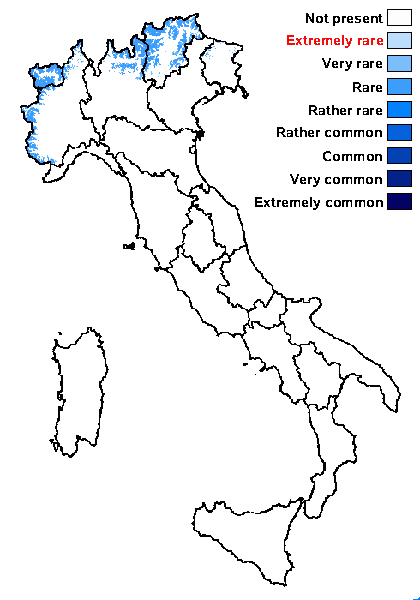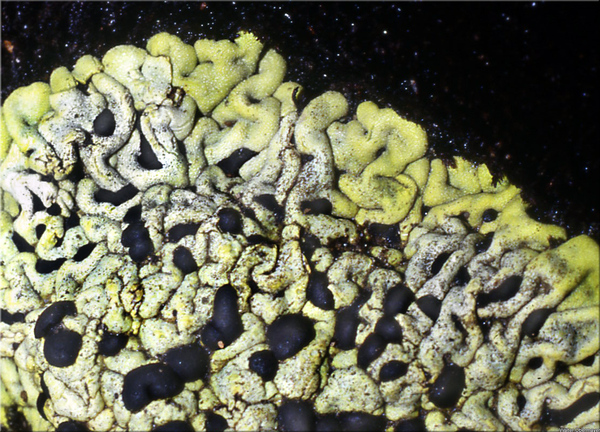Catolechia wahlenbergii (Ach.) Körb.
Syst. Lich. Germ.: 181, 1855. Basionym: Lecidea wahlenbergii Flot. ex Ach. - Meth. Lich.: 81, tab. 2, fig. 2, 1803.
Synonyms: Buellia pulchella (A. Massal.) Tuck.; Buellia wahlenbergii (Ach.) Sheard; Catolechia galbula (DC.) Anzi; Catolechia pulchella A. Massal.; Lecidea galbula (DC.) Nyl.; Lichen pulchellus Schrad. nom. illegit.; Psora galbula DC.; Toninia galbula (DC.) Boistel
Distribution: N - Frl (Tretiach & Hafellner 2000), TAA (Caniglia & al. 2002, Nascimbene & al. 2022), Lomb, Piem (Isocrono & al. 2004), VA (Piervittori & Isocrono 1999).
Description: Thallus squamulose to subcrustose-placodioid, bright yellow-green, sometimes with brownish patches, very thick. Squamules convex, contiguous, wrinkled, to 3 mm broad, the marginal ones to c. 1 cm long, developing on a black prothallus. Upper surface inspersed with yellowish granules, later covered by a thick epinecral layer; lower surface black, attached by numerous bundles of black rhizinoids. Medulla white in upper part, dark brown in lower part, thick, I-. Apothecia frequent, lecideine to biatorine, rounded, sessile, up to 2 mm across, developing among the squamules, with a black, flat to convex disc, and a thin, concolorous, soon excluded proper margin. Proper exciple dark reddish brown; epithecium dark olive-green to blackish, K-, N+ red; hymenium colourless, I+ blue; paraphysoids densely branched and anastomosing from the base, the apical cells hardly swollen; hypothecium dark, of radially arranged hyphae. Asci 8-spored, clavate, with a I+ blue outer gelatinous coat, thickened at apex, with an internal I+ deep blue cap. Ascospores 0-1(-3)-septate, the central septum with an internal torus, brown, ellipsoid with rounded ends, 12-18 x 7-10 μm, without a gelatinous perispore. Photobiont chlorococcoid. Spot tests: thallus K- , C-, KC-, P+ yellow-orange, UV+ orange. Chemistry: two pulvinic acid derivatives and additional unknown compounds.Note: an arctic-alpine, probably circumpolar lichen found on acid soil rich in humus and over bryophytes in fissures of siliceous rocks in cold, perennially humid situations above or near treeline; restricted to the Alps in Italy.
Growth form: Foliose, broad lobed
Substrata: soil, terricolous mosses, and plant debris
Photobiont: green algae other than Trentepohlia
Reproductive strategy: mainly sexual
Commonnes-rarity: (info)
Alpine belt: rare
Subalpine belt: very rare
Oromediterranean belt: absent
Montane belt: absent
Submediterranean belt: absent
Padanian area: absent
Humid submediterranean belt: absent
Humid mediterranean belt: absent
Dry mediterranean belt: absent

Predictive model
Herbarium samples


P.L. Nimis; Owner: Department of Life Sciences, University of Trieste
Herbarium: TSB (11893)
2001/11/23
Growth form: Foliose, broad lobed
Substrata: soil, terricolous mosses, and plant debris
Photobiont: green algae other than Trentepohlia
Reproductive strategy: mainly sexual
Commonnes-rarity: (info)
Alpine belt: rare
Subalpine belt: very rare
Oromediterranean belt: absent
Montane belt: absent
Submediterranean belt: absent
Padanian area: absent
Humid submediterranean belt: absent
Humid mediterranean belt: absent
Dry mediterranean belt: absent

Predictive model
| Herbarium samples |


 INDEX FUNGORUM
INDEX FUNGORUM
 GBIF
GBIF
 DOLICHENS
DOLICHENS




